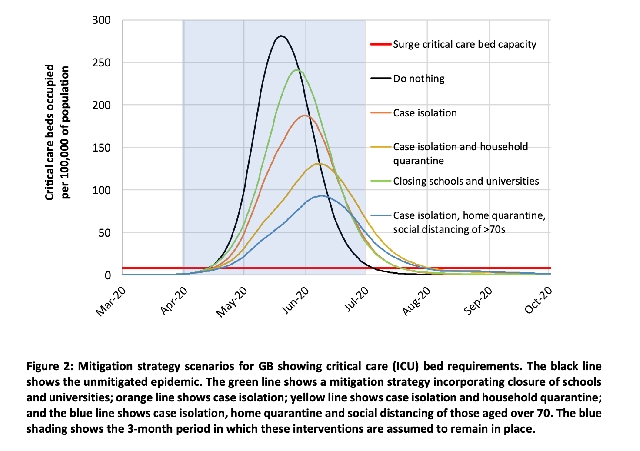COVID-19: Lockdowns work
 Coronavirus has killed thousands in China and around the world
Coronavirus has killed thousands in China and around the world
The UK, US, EU and many other countries are currently in some degree of “lockdown,” with restaurants and bars, shops, schools and gyms closed, and citizens required, or at least strongly encouraged, to stay home to avoid catching or spreading COVID-19, the respiratory illness caused by the novel coronavirus.
Researchers are well on their way to discovering vaccines and treatments for the virus, but even in a best-case scenario, these are likely to be 12-18 months away.
Until then, extreme social distancing is pretty much the only intervention available to help individuals stay healthy, and to break the chain of transmission - giving more vulnerable populations a fighting chance of surviving this pandemic.
But how exactly does a lockdown work? And why is it important for even younger and healthier people, who face a lower risk of severe illness, to remain in their homes as much as possible?
The goal: R<1
The purpose of a lockdown, explains a new study from the Imperial College London COVID-19 Response Team, is to reduce reproduction – in other words, to reduce the number of people each confirmed case infects.
The goal is to keep reproduction, or “R,” below one (R<1) – with each case infecting fewer than one other person, on average.
The authors of the study say there are two routes to try to get there:
Mitigation, “slowing but not necessarily stopping epidemic spread – reducing peak healthcare demand while protecting those most at risk of severe disease from infection.” This is done by isolating suspected cases and their households, and social distancing the elderly and people at highest risk of serious illness. Suppression, or basically, lockdown, which “aims to reverse epidemic growth, reducing case numbers to low levels” by social distancing the entire population “indefinitely” and closing schools and universities.
The study’s models show that, painful as lockdown may be for many of us, it works.
Without any lockdown or social distancing measures, we can expect peak mortality in approximately three months. In this scenario, 81% of the UK and US populations would be infected, with 510,000 dying in the UK and 2.2 million dying in the US.

In contrast, isolating confirmed and suspected cases and social distancing the elderly and vulnerable would “reduce peak critical care demand by two-thirds and halve the number of deaths.”
To get closer to the goal of R<1, they say, “a combination of case isolation, social distancing of the entire population and either household quarantine or school and university closure are required."
The study finds this "intensive policy is predicted to result in a reduction in critical care requirements from a peak approximately three weeks after the interventions are introduced and a decline thereafter while the intervention policies remain in place."

While the word “indefinitely” isn’t one we want to hear, it’s possible long-term suppression could be the best way to reduce infections and deaths – at least until a vaccine is available.
So, have the lockdowns worked?
Starting 23 January 2020, the Chinese government locked down Hubei Province, including Wuhan, the city of 11 million where the outbreak started. They halted transportation in and out and barred tens of millions of people from working or going to school and closed all shops except those selling food or medicine. In some areas, residents were even forced to limit trips to the store, or order supplies for delivery.
This unprecedented lockdown of tens of millions of people was considered a “vast experiment” – but it may have worked. Following the lockdown, cases began to slow. On 19 March, China’s National Health Commission reported no new confirmed infections in Hubei.

Italy and Spain have been under similarly intense nationwide lockdowns, from 9 March and 15 March, respectively, with citizens required to stay in their homes except for work, food shopping or medical appointments.
In parts of Italy where lockdowns started earlier, however, we're already seeing a "flattening of the curve". Lodi, for example, locked down on 23 February, but Bergamo did not lockdown until 8 March. Now, cases seem to be levelling off in Lodi.

This week, both Italy and Spain reported their largest daily increases in COVID-19-related deaths. But if the lockdown models, hypothetical and real, are correct, the peaks could be approaching.
Trending News

NPP Performance Tracker emphasizes toilets over substantive infrastructure dev’t projects — Dr. Sa-ad Iddrisu
09:00
2024 Green Ghana Day slated for June 7 | Yaa Naa calls for active participation
14:10
Akufo-Addo/Bawumia gov’t planning to rename Ameri Plant to Kumasi 1 Thermal Plant – Edudzi Tameklo
10:23
NPP PWDs affirm support for Bawumia
08:54
NDC outdoors Naana Opoku-Agyemang April 24
11:46
I am deeply saddened by the destruction caused by the recent fire at Madina Market-Alan Kyerematen
02:29
Parliament reconvenes late May, denies Bagbin delaying recall over NDC ties
08:37
Judgment day for former MASLOC boss, others today
11:14
UEW distance education students call for MoE’s intervention over graduation requirement dispute
02:40
Gov't plans to revise traditional customs following controversial Gborbu marriage
08:30



